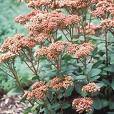| Kingdom | Plantae |
| Division | Magnoliophyta |
| Class | Magnoliopsida |
| Order | Saxifragales |
| Family | Crassulaceae |
| Genus | Sedum |
| Species | S.telephium |
| Binomial name | Sedum telephium |
Other Common Names:
The other common names for the herb orpine are Evergreen, Frog Plant,Live-forever,Live-long,Stonecrop and Witches'-moneybags.
History
The common name Orpine, is derived from Auripigmentum, the gold-coloured pigment, called Orpiment, or Orpin, a yellow sulphuret of the metal arsenic. The specific name is derived from Telephus, the son of Hercules, who is said to have discovered its virtues. He used this herb live long to cure a battle-wounded leg that had not otherwise healed. It is also known as "midsummer men" this herb was once gathered on Midsummer's Eve to determine the future of a love relationship where two leaves would be placed side-by-side and if they fell toward each other, love was true.

Description
Live-long is a perennial herb which grows up to three feet tall. The root-stock is large and fleshy, producing small parsnip-shaped tubers, with a whitish-grey rind, containing a considerable store of nourishment. The stalks are numerous, erect, unbranched, round and solid, generally of a reddish tint, spotted and streaked with a deeper red above. There are numerous leaves which are alternately placed on the stem at short intervals and are flat, fleshy leaves, bluish-green in colour and coarsely toothed.

Range
Orpine is indigenous to temperate zones and a native of Britain. It is widely distributed in Belgium, Finland, France; Germany,Italy,Spain and New York. In the tropics, live-long grows in the mountains and in cooler regions it thrives in lower locations such as hedge banks on the shady sides of woods.
Habitat
The plant prefers light sandy, medium loamy and heavy clay soils well-drained soil. The plant prefers acid, neutral and basic alkaline soils. It can grow in full shade, semi-shade or no shade. It requires dry or moist soil and can tolerate drought. Thus it is mostly seen in hedge banks and the shady sides of damp woods.
Cultivation
The seed is sown in spring in well-drained soil in a sunny position. Do not allow the soil to dry out. The seedlings are pricked into individual pots when they are large enough to handle. If sufficient growth is made, it is possible to plant them out during the summer, otherwise keep them in a cold-frame or greenhouse for their first winter and plant them out in early summer of the following year. Division is very easy and can be carried out at almost any time in the growing season, though is probably best done in spring or early summer. Larger divisions can be planted out direct into their permanent positions. It is best to pot up the smaller divisions and grow them on in a lightly shaded position in a cold frame, planting them out once they are well established in the summer. Cuttings can be taken at almost any time in the growing season, though early in the season is probably best.
Flowering Season
The flowers are in bloom generally in the midsummer. Thus it flowers in July and seeds in August.
Pests and Diseases
Mealybug is a common pest which can weaken a plant leading to yellow foliage and leaf drop. They also produce a sweet substance called honeydew which can lead to an unattractive black surface fungal growth called sooty mold.Orpine is also affected by slugs and snails which may eat holes in leaves, strip entire stems, or completely devour seedlings and tender transplants, leaving behind tell-tale silvery, slimy trails. Scales are insects, related to mealy bugs that can be a problem on a wide variety of plants - indoor and outdoor.
Parts Used

The whole herb is of both medicinal and commercial use. However the leaves are the most commonly used part.
Medicinal Applications
• It cools any inflammation upon any hurt, burns or wound, and eases the pain.
• The juice of orpine's leaves is used in the treatment of skin diseases, wounds and fistulas.
• Live-long is used to treat stomach, lung, liver, and bowel problems, burns, inflammation, and sore throats.
• The decoction of orpine is a remedy for diarrhea.
• It stimulates the action of the kidneys, and to be serviceable for piles and hemorrhages.
• The plant has astringent and cytostatic properties.
• Orpine has shown evidence in the treatment of cancer.
• A poultice of the crushed leaves has been used in the treatment of boils and carbuncles.
Commercial Applications
• The leaves have sometimes been used as a salad.
• The roots are cooked and used in soups, stews etc.

The 16th-century herbalist John Gerard remarked about orpine as "noting that one could set a stalk of it in clay and the stalk would stay green and even grow if watered". This resistance to drying and dying made live-long an object of superstition over the ages: Keeping it in the house ensured a healthy household. In Scandinavia live-long was planted on the roof to ward off lightning. If it suddenly withered, superstition held that someone in the house would die.